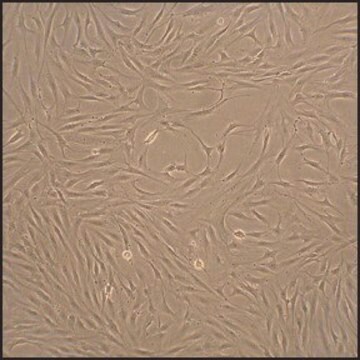408OA-05A
Human Fibroblast-Like Synoviocytes-Osteoarthritis: HFLS-OA, adult
Sinónimos:
Human fibroblast culture
About This Item
Productos recomendados
biological source
human synovial tissues (osteoarthritic)
Quality Level
packaging
pkg of 500,000 cells
manufacturer/tradename
Cell Applications, Inc
growth mode
Adherent
karyotype
2n = 46
morphology
Fibroblast-like
technique(s)
cell culture | mammalian: suitable
relevant disease(s)
arthritis; coagulation disorders
shipped in
dry ice
storage temp.
−196°C
General description
HFLS-RA provide an excellent cellular model for studying synoviocyte physiology in relation to development and treatment of rheumatoid arthritis.
HFLS-RA have been used in numerous research studies to:
- Study signaling pathways implicated in the development of joint inflammation and rheumatoid arthritis (Abe, 2006; Akasaka, 2005; Bai, 2012; Fan, 2013; Furuhashi, 2008; Hashizume, 2008; Matsuyama, 2010; Tsuji, 1999; Yamaguch, 2012a,b; Yano, 2001)
- Evaluate possible contribution of EBV to nonresolving rheumatoid arthritis inflammation through inducing IL-6 production by synoviocytes (Chiu, 2013)
- Evaluate the anti-inflammatory and antirheumatic activity of various compounds, such as celastrol (Venkatesha, 2011; Xu, 2013), triptolide (Kong, 2013; Lin, 2013), arsenic trioxide (Mei, 2011), Wen Luo Yin (Liu, 2013), bucillamine (Tsuji, 2007), therapeutic lyposomes (Harigai, 2007; Ichihara, 2011; Matsumoto, 2013; Negishi, 2011), anti-IL-6R and anti-CD319 antibodies (Suzuki, 2010; Woo, 2013), as well as inhibitors of NF-κB (Baima, 2010; Keith, 2005), methionine aminopeptidase-2 (Bernier, 2004), Tpl2 (Hall, 2007), aryl hydrocarbon receptor (Lahoti, 2013) and p38 MAP kinase (Wada, 2005); and additionally demonstrate the beneficial anti-inflammatory effects of low level light therapy (Yamaura, 2009)
- Investigate the causes of metalloproteinases induction in patients with Lyme disease-associated arthritis (Lin, 2001)
- Develop adenovirus-based siRNA delivery system (Arts, 2003)
Additionally, together with normal HFLS, HFLS-RA were used to:
- Identify causing agents (such as uric acid crystals or platelet microparticles) and study the immunopathological mechanisms and signal transduction pathways leading to joint inflammation in rheumatoid arthritis (Chen, 2011a; Hsu, 2012; Mathieu, 2008; Tsuji, 2012), and to demonstrate the role of estrogen signaling in increasing inflammation (Galal, 2008)
- Investigate anti-inflammatory properties of herbal compound Sinomenine suggested for rheumatoid arthritis treatment (Chen, 2011b)
- Study the effects of extracellular matrix composition on cell attachment and migration relevant to T-cell function in inflamed tissues (Evanko, 2012)
In parallel with HFLS isolated from joints of patients with osteoarthritis HFLS-RA were used in a study demonstrating the involvement of capsid proteins of parvorvirus B19 in activating synoviocyte migration and induction of the inflammatory response leading to acute symmetrical polyarthropathy (Lu, 2006).
Finally, all three types of HFLS (normal, RA and OA) were used to investigate the role of human endogenous retroviruses (HERVs) in development of rheumatoid arthritis, and suggest that activated expression of different forms of HERV contribute to development of rheumatoid arthritis symptoms by different mechanisms (Freimanis, 2010).
Cell Line Origin
Application
Components
Preparation Note
- 2nd passage, >500,000 cells in Basal Medium containing 10% FBS & 10% DMSO
- Can be cultured at least 5 doublings
Subculture Routine
Disclaimer
Storage Class
11 - Combustible Solids
wgk_germany
WGK 3
flash_point_f
Not applicable
flash_point_c
Not applicable
Certificados de análisis (COA)
Busque Certificados de análisis (COA) introduciendo el número de lote del producto. Los números de lote se encuentran en la etiqueta del producto después de las palabras «Lot» o «Batch»
¿Ya tiene este producto?
Encuentre la documentación para los productos que ha comprado recientemente en la Biblioteca de documentos.
Los clientes también vieron
Nuestro equipo de científicos tiene experiencia en todas las áreas de investigación: Ciencias de la vida, Ciencia de los materiales, Síntesis química, Cromatografía, Analítica y muchas otras.
Póngase en contacto con el Servicio técnico









